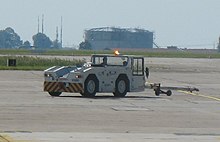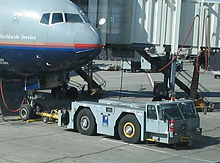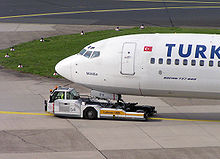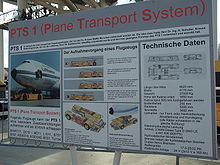Aircraft tug

An aircraft tractor (also called a “pusher”) is a vehicle that can tow, push (push) or position aircraft on taxiways . It is used to move aircraft on the runway and in maintenance hangars. The also common name tug comes from the English term for harbor tugs .
Aircraft tugs come in very different designs in all areas of aviation. The range extends from hand-operated four- kilowatt mini-tugs for sport aircraft to 70-ton tugs for moving large passenger aircraft. Well-known manufacturers include Goldhofer and FMC Technologies .
The process of backing up the aircraft before departure with the help of an aircraft tractor is called pushback . The engines can then be started during the pushback, which is monitored by the accompanying mechanic, ramp agent or the walk-out assistant.
Towing with a tow bar
In this form, a rod is attached between the tractor and the aircraft nose wheel landing gear . This tow bar transfers all forces and is equipped with shear bolts to prevent damage to the aircraft in the event of an overload. This technique is the common technique used in general aviation for moving aircraft that are too heavy to be moved manually using a hand tow bar.
With this method, a so-called "brakeman" (a mechanic or pilot) should always be present in the cockpit, who can bring the aircraft to a standstill with his own brakes in the event of a break in the towbar.
The tug must have enough weight and therefore static friction to be able to pull a heavy aircraft with the rod. A solution to the construction of increasingly heavier tugs for larger aircraft was the introduction of the lifting system, in which the nose landing gear of an aircraft is raised, with which part of the aircraft's weight provides traction:
Towing without a tow bar
Here, specially designed tugs grasp and raise the nose wheel landing gear of the aircraft. The nose wheel landing gear is taken piggyback . This method considerably simplifies the towing maneuver, since the aircraft cannot be lost due to a breaking or tearing off tow bar, which makes the brake in the aircraft superfluous. In addition, the maneuvering of the aircraft is considerably simplified here, as the lack of a tow bar eliminates the need for a rotatable connection. The tractor can also be made considerably lighter, as the nose wheel load is transferred to it and it thus receives additional traction . Further advantages of this method are a higher towing speed (up to 30 km / h). For the operator of such towbarless aircraft tugs, there is also no need for towbar logistics at the airport or its maintenance.
There are also aircraft tugs that attach to one of the main landing gear wheels. Such a device includes the main wheel with rollers and thus pushes or pulls the aircraft. The tug is controlled by a person who is in communication with the pilot . The pilot controls the nose wheel on instruction and sets or releases the parking brake. An example of this is the PowerPush from Schopf.
At Frankfurt Airport are in July 2014, the TaxiBot diesel-electric powered aircraft tractor in testing, the aircraft after pushback on the taxiway should drag until shortly before the start position. After the driver of the tractor has reset it from the parking position, the operating mode is changed and the pilot takes over control. The tractor starts like an automatic vehicle after releasing the landing gear brakes of the aircraft, it interprets the steering movements of the nose wheel via sensors and converts them into appropriate changes of direction. This enables the aircraft to cover most of the distance on the ground without the engines running, which reduces fuel consumption and noise emissions . In addition, the parking positions can be cleared more quickly, since the engines no longer necessarily have to be started.
Military aircraft tugs
On the whole, military aircraft tugs for combat aircraft and military helicopters are comparable to their civilian counterparts, but there are some differences. Military aircraft tugs are built very compact and have an extremely small turning circle in order to be able to work on small areas (e.g. aircraft carriers) or in tight spaces ( aircraft caverns or armored aircraft shelters). With some aircraft tugs (such as the Mowag aircraft tractor ), the driver can disengage the aircraft from the towing arm while driving. With the Mirage III of the Swiss Air Force, this was the standard procedure for operations from the aircraft caverns after the aircraft had started its engine. Military aircraft tugs that are used in caverns and aircraft shelters are equipped with diesel engines (no spark plugs as in gasoline engines to reduce the risk of explosion from kerosene fumes). For precise maneuvering in the caverns and shelters, some aircraft tugs are equipped with a special floor lighting unit - with the light cone of this headlight, the driver has to follow the floor markings of the corresponding aircraft type in towing mode in order to be able to drive quickly and safely in tight spaces.
Military aircraft tugs (such as the Bucher aircraft tugs ) are also used to supply power to small jets without an APU and as tractors for engine starter units, weapon systems or additional tanks.
In the Soviet Union, heavy trucks were sometimes used to tow military aircraft. For example, the MAZ-537 armored transporter was available in a version with a special gearbox that made it possible to move machines weighing up to 200 tons with a tow bar.
Web links
Individual evidence
- ^ Goldhofer AG: Airport Equipment / Airport Technology. PDF, p. 5 ( Memento from September 24, 2015 in the Internet Archive ).
- ↑ Frankfurt Airport tests new tugs , FAZ , July 22, 2014; TaxiBot Information , Lufthansa-LEOS (accessed December 5, 2014).
- ↑ Website for the MAZ-537 and its model versions (Russian).






